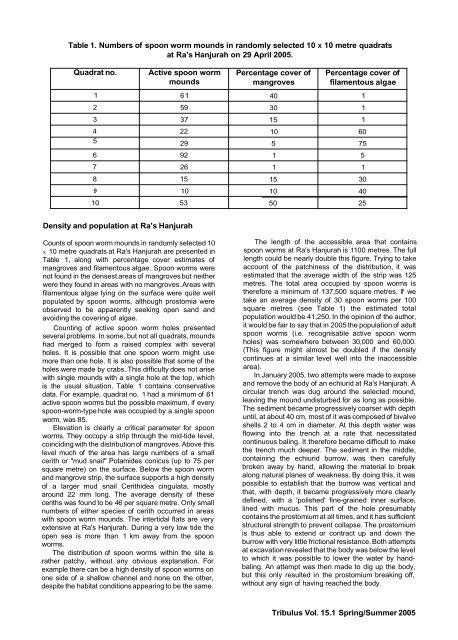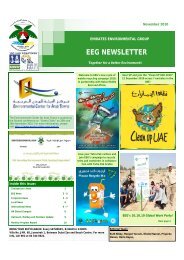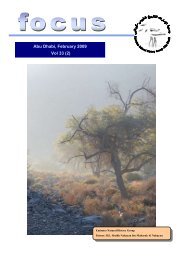Oman (Lepidoptera: Pieridae) - Al Ain Chapter, Emirates Natural ...
Oman (Lepidoptera: Pieridae) - Al Ain Chapter, Emirates Natural ...
Oman (Lepidoptera: Pieridae) - Al Ain Chapter, Emirates Natural ...
You also want an ePaper? Increase the reach of your titles
YUMPU automatically turns print PDFs into web optimized ePapers that Google loves.
Table 1. Numbers of spoon worm mounds in randomly selected 10 X 10 metre quadrats<br />
at Ra's Hanjurah on 29 April 2005.<br />
Quadrat no.<br />
1<br />
2<br />
3<br />
4<br />
5<br />
6<br />
7<br />
8<br />
9<br />
10<br />
Active spoon worm<br />
mounds<br />
Density and population at Ra's Hanjurah<br />
Counts of spoon worm mounds in randomly selected 10<br />
x 10 metre quadrats at Ra's Hanjurah are presented in<br />
Table 1, along with percentage cover estimates of<br />
mangroves and filamentous algae. Spoon worms were<br />
not found in the densest areas of mangroves but neither<br />
were they found in areas with no mangroves. Areas with<br />
filamentous algae lying on the surface were quite well<br />
populated by spoon worms, although prostomia were<br />
observed to be apparently seeking open sand and<br />
avoiding the covering of algae.<br />
Counting of active spoon worm holes presented<br />
several problems. In some, but not all quadrats, mounds<br />
had merged to form a raised complex with several<br />
holes. It is possible that one spoon worm might use<br />
more than one hole. It is also possible that some of the<br />
holes were made by crabs. This difficulty does not arise<br />
with single mounds with a single hole at the top, which<br />
is the usual situation. Table 1 contains conservative<br />
data. For example, quadrat no. 1 had a minimum of 61<br />
active spoon worms but the possible maximum, if every<br />
spoon-worm-type hole was occupied by a single spoon<br />
worm, was 85.<br />
Elevation is clearly a critical parameter for spoon<br />
worms. They occupy a strip through the mid-tide level,<br />
coinciding with the distribution of mangroves. Above this<br />
level much of the area has large numbers of a small<br />
cerith or "mud snail" Potamides conicus (up to 75 per<br />
square metre) on the surface. Below the spoon worm<br />
and mangrove strip, the surface supports a high density<br />
of a larger mud snail Cerithidea cingulata, mostly<br />
around 22 mm long. The average density of these<br />
ceriths was found to be 46 per square metre. Only small<br />
numbers of either species of cerith occurred in areas<br />
with spoon worm mounds. The intertidal flats are very<br />
extensive at Ra's Hanjurah. During a very low tide the<br />
open sea is more than 1 km away from the spoon<br />
worms.<br />
The distribution of spoon worms within the site is<br />
rather patchy, without any obvious explanation. For<br />
example there can be a high density of spoon worms on<br />
one side of a shallow channel and none on the other,<br />
despite the habitat conditions appearing to be the same.<br />
6 1<br />
59<br />
37<br />
22<br />
29<br />
92<br />
26<br />
15<br />
10<br />
53<br />
Percentage cover of<br />
mangroves<br />
40<br />
30<br />
15<br />
10<br />
5<br />
1<br />
1<br />
15<br />
10<br />
50<br />
Percentage cover of<br />
filamentous algae<br />
1<br />
1<br />
1<br />
60<br />
75<br />
5<br />
1<br />
30<br />
40<br />
25<br />
The length of the accessible area that contains<br />
spoon worms at Ra's Hanjurah is 11 00 metres. The full<br />
length could be nearly double this figure. Trying to take<br />
account of the patchiness of the distribution, it was<br />
estimated that the average width of the strip was 125<br />
metres. The total area occupied by spoon worms is<br />
therefore a minimum of 137,500 square metres. If we<br />
take an average density of 30 spoon worms per 100<br />
square metres (see Table 1) the estimated total<br />
population would be 41,250. In the opinion of the author,<br />
it would be fair to say that in 2005 the population of adult<br />
spoon worms (i.e. recognisable active spoon worm<br />
holes) was somewhere between 30,000 and 60,000.<br />
(This figure might almost be doubled if the density<br />
continues at a similar level well into the inaccessible<br />
area).<br />
In January 2005, two attempts were made to expose<br />
and remove the body of an echiurid at Ra's Hanjurah. A<br />
circular trench was dug around the selected mound,<br />
leaving the mound undisturbed for as long as possible.<br />
The sediment became progressively coarser with depth<br />
until, at about 40 cm, most of it was composed of bivalve<br />
shells 2 to 4 cm in diameter. At this depth water was<br />
flowing into the trench at a rate that necessitated<br />
continuous baling. It therefore became difficult to make<br />
the trench much deeper. The sediment in the middle,<br />
containing the echiurid burrow, was then carefully<br />
broken away by hand, allowing the material to break<br />
along natural planes of weakness. By doing this, it was<br />
possible to establish that the burrow was vertical and<br />
that, with depth, it became progressively more clearly<br />
defined, with a 'polished' fine-grained inner surface,<br />
lined with mucus. This part of the hole presumably<br />
contains the prostomium at all times, and it has sufficient<br />
structural strength to prevent collapse. The prostomium<br />
is thus able to extend or contract up and down the<br />
burrow with very little frictional resistance. Both attempts<br />
at excavation revealed that the body was below the level<br />
to which it was possible to lower the water by hand-<br />
baling. An attempt was then made to dig up the body,<br />
but this only resulted in the prostomium breaking off,<br />
without any sign of having reached the body.<br />
Tribulus Vol. 15.1 Spring/Summer 2005




